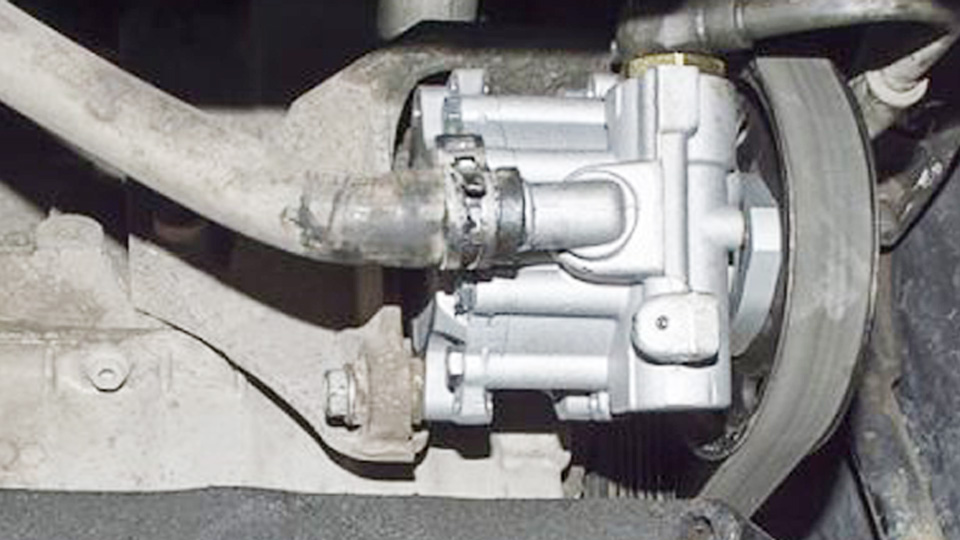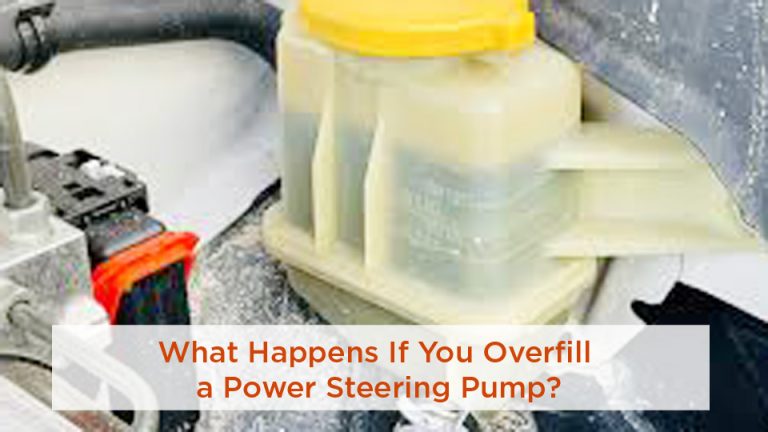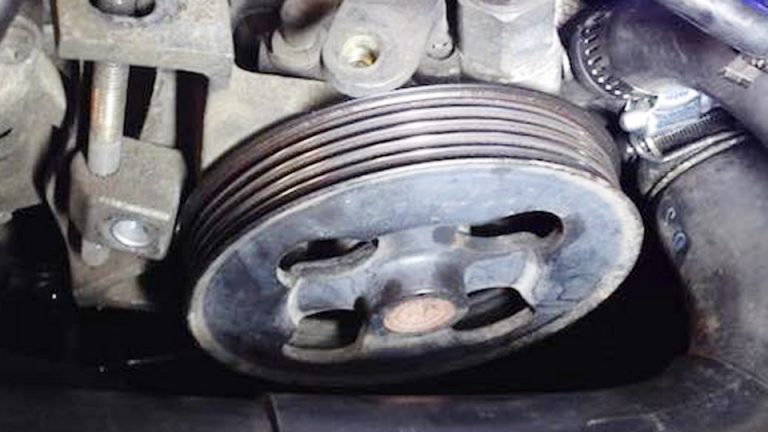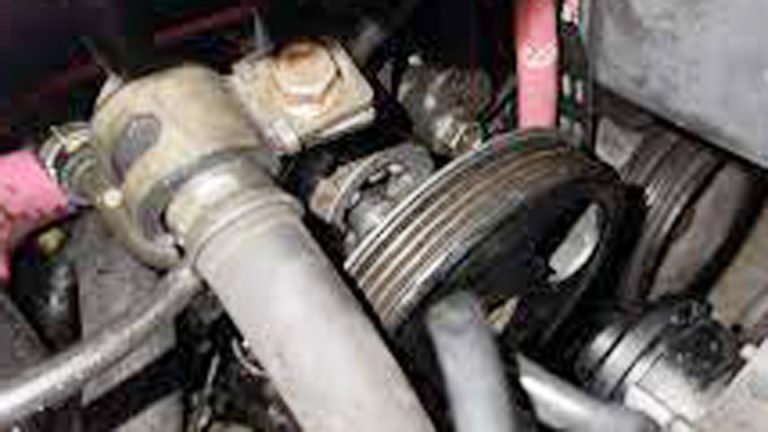One of the easiest ways to tell something’s wrong with your car is how the steering feels. If it suddenly takes more muscle to turn the wheel, or you hear strange whining noises every time you park, your power steering pump might be to blame.
So, how do you check if your power steering pump is bad? The pump is the heart of the power steering system, and when it weakens, you’ll notice symptoms like stiff steering, fluid leaks, or vibrations through the wheel. I’ve seen plenty of drivers ignore these signs, topping up fluid again and again, only to end up with a pump that completely fails on the road.
The truth is, you don’t need fancy tools to spot the warning signs early. With a few simple checks—listening, looking, and feeling how the wheel responds—you can figure out whether it’s really the pump or something else in the steering system.

Image by breakerlink
What Is a Power Steering Pump and Why Does It Matter?
What the Part Is and What It Does
The power steering pump is a compact but mighty component, usually bolted to your engine and driven by a belt. Its job? To pressurize power steering fluid and send it to the steering gear or rack, reducing the effort needed to turn your wheels. Without it, you’d be muscling your steering wheel like you’re driving a semi-truck from the ‘70s. It’s critical for safety, especially at low speeds or in tight spots like parking lots. A healthy pump ensures smooth, predictable steering, which is non-negotiable for safe driving.
Why It Matters
A failing pump doesn’t just make steering harder—it can compromise your control on the road. Imagine trying to dodge a pothole or make a quick turn with a stiff wheel. Not fun, right ? Plus, a bad pump can leak fluid, overheat, or damage your steering rack, leading to repairs that’ll hit your wallet harder than a set of premium tires. Catching issues early saves you money, keeps your car reliable, and ensures you’re not stranded with a steering system that’s gone AWOL.
Signs Your Power Steering Pump Is Failing
Common Problems or Signs of Failure
I’ve seen my fair share of bad pumps in the shop, and the symptoms are usually pretty clear once you know what to look for. Here’s what to watch out for:
Whining or Groaning Noises: A high-pitched whine when you turn the wheel, especially at low speeds, often means the pump is struggling. It’s usually caused by low fluid, air in the system, or worn internal components.
Stiff or Heavy Steering: If turning feels like a gym workout, the pump might not be delivering enough pressure. This can be worse in colder weather or during tight maneuvers.
Fluid Leaks: Check under your car for red or brown puddles near the front. Power steering fluid leaks often point to a failing pump seal or hose.
Erratic Steering Response: If your steering feels jerky or inconsistent, the pump might be sending uneven pressure to the steering gear.
Screeching Belt: A loose or worn serpentine belt driving the pump can mimic pump failure symptoms, so don’t overlook it.
Personal Anecdote
Last summer, a buddy brought his 2010 Ford F-150 to my garage, complaining about a whine every time he parked. I popped the hood, checked the fluid—bone dry. After topping it off and bleeding the system, the noise was still there. A quick pressure test confirmed the pump was toast. Moral of the story? Don’t ignore that whine—it’s your car begging for help.
How to Diagnose a Bad Power Steering Pump
Step-by-Step Guide to Checking Your Pump
Diagnosing a power steering pump isn’t rocket science, but it takes a bit of patience and the right tools. Here’s how I do it in the shop, step by step:
- Check the Fluid Level:
- Pop the hood and locate the power steering reservoir (usually near the firewall, with a cap labeled “PS” or a steering wheel icon).
- Check the fluid level against the dipstick or reservoir markings. Low fluid can mimic pump failure.
- Look at the fluid’s color and condition. It should be clear and reddish, not dark, gritty, or foamy.
Listen for Noises:
- Start the engine and turn the steering wheel lock-to-lock (full left to full right).
- A healthy pump is quiet. A whine or groan usually means air in the system, low fluid, or a failing pump.
Inspect for Leaks:
- Look under the car and around the pump for wet spots or drips. Check hoses and connections too.
- If you see fluid, trace it back to the source. A leaky pump seal is a common culprit.
Test Steering Effort:
- With the engine running, turn the wheel. It should feel smooth and light.
- If it’s stiff or jerky, the pump might not be generating enough pressure.
Perform a Pressure Test (Advanced):
- If you’ve got a pressure gauge (available at auto parts stores for about $50), connect it to the pump’s output line.
- Most pumps should produce 1,000–1,500 PSI at idle. If it’s significantly lower, the pump’s internals are likely worn out.
Tools You’ll Need
- Flashlight
- Rags for checking fluid
- Power steering pressure tester (optional but handy)
- Basic wrench set (for hose inspection)
- Safety glasses (fluid can splash)
Common Mistakes to Avoid
Ignoring Low Fluid: Topping off a low reservoir without fixing the leak is like putting a Band-Aid on a broken leg.
Using the Wrong Fluid: Check your owner’s manual. Some cars (like Hondas) use specific fluids, and the wrong one can wreck your pump.
Overlooking the Belt: A loose or glazed serpentine belt can cause similar symptoms, so check its tension and condition.
When and Why to Replace a Power Steering Pump
When Replacement Is Needed
You’ll need to replace the pump if:
- It’s leaking and seals can’t be repaired.
- Pressure tests show low output (below spec).
- Noises persist after bleeding the system and topping off fluid.
- Steering remains stiff despite a healthy fluid level and belt.
Delaying replacement can overwork your steering rack or gear, leading to a $500–$1,000 repair bill. I’ve seen folks limp along with a bad pump, only to end up with a totaled steering system. Don’t be that guy.
Why Act Fast?
A bad pump doesn’t just make driving harder—it’s a safety hazard. Losing steering control in an emergency is a nightmare. Plus, replacing a pump early (around $100–$300 for parts, $200–$600 with labor) is cheaper than rebuilding an entire steering system.
OEM vs Aftermarket Power Steering Pumps
OEM vs Aftermarket: What’s the Difference?
- OEM (Original Equipment Manufacturer): These are pumps made by the same company that built your car’s original part (e.g., ACDelco for GM, Motorcraft for Ford). They’re designed to match your vehicle’s specs exactly.
- Aftermarket: Made by third-party brands like Cardone, Bosch, or Dorman. They’re often cheaper but vary in quality.
OEM vs Aftermarket Power Steering Pumps
| Feature | OEM Pumps | Aftermarket Pumps |
|---|---|---|
| Price | $150–$400 | $50–$200 |
| Quality | OEM-spec, reliable | Varies (some match OEM, others don’t) |
| Warranty | 1–2 years, sometimes longer | 1 year or lifetime (brand-dependent) |
| Fitment | Perfect fit for your vehicle | Usually good, but check compatibility |
| Availability | Dealer or online (e.g., RockAuto) | Widely available (AutoZone, Amazon) |
| Top Brands | ACDelco, Motorcraft, Mopar | Cardone, Bosch, Dorman |
Pros and Cons
OEM Pros:
- Guaranteed fit and performance.
- Often longer-lasting.
- Trusted by dealerships for repairs.
OEM Cons:
- More expensive.
- Harder to find for older models.
Aftermarket Pros:
- Budget-friendly.
- Widely available, even for rare vehicles.
- Some brands (e.g., Bosch) rival OEM quality.
Aftermarket Cons:
- Quality varies widely—stick to reputable brands.
- May not last as long as OEM in some cases.
US Market Examples
For a 2015 Chevy Silverado, an ACDelco OEM pump might run $250, while a Cardone remanufactured pump costs $80 at AutoZone. For a 2008 Honda Accord, a Honda OEM pump is around $300, but a Dorman aftermarket unit is $120. Always check vehicle compatibility using your VIN or a parts lookup tool on sites like RockAuto or Advance Auto Parts.
How to Spot Fake Parts
Counterfeit pumps are a real issue, especially online. Here’s how to avoid them:
- Check Packaging: OEM parts come in branded boxes with holograms or serial numbers.
- Buy from Reputable Sources: Stick to dealers, AutoZone, O’Reilly, or trusted online retailers like RockAuto.
- Inspect the Part: Look for sloppy casting, missing brand logos, or cheap-looking materials.
- Verify Part Numbers: Cross-reference the part number with your vehicle’s manual or a dealer.
How to Replace a Power Steering Pump
Installation Tips
Replacing a pump is a solid DIY job if you’ve got basic tools and a few hours. Here’s a quick guide based on swapping a pump on a 2012 Dodge Ram last month:
Prep the Car:
- Park on a flat surface, engage the parking brake, and disconnect the battery.
- Jack up the front end for better access (use jack stands for safety).
Drain the System:
- Place a drain pan under the pump.
- Disconnect the return hose and let the fluid drain.
Remove the Old Pump:
- Loosen the serpentine belt (use a tensioner tool or wrench).
- Disconnect the pressure and return hoses (have rags ready for spills).
- Unbolt the pump (usually 2–3 bolts, 12mm or 14mm).
Install the New Pump:
- Bolt the new pump in place, ensuring proper alignment.
- Reconnect hoses and tighten fittings (don’t overtighten—snug is enough).
- Reinstall the belt, checking tension.
Refill and Bleed the System:
- Fill the reservoir with the correct fluid.
- Turn the wheel lock-to-lock with the engine off to bleed air.
- Start the engine, top off fluid, and bleed again until the steering is smooth.
Tools Needed
- Socket set (10mm–14mm)
- Wrench set
- Tensioner tool
- Drain pan
- Funnel for fluid
- Jack and jack stands
Common Mistakes
- Not Bleeding the System: Air bubbles cause whining and poor performance. Take your time bleeding.
- Mixing Fluids: Stick to the manufacturer’s recommended fluid type.
- Over-tightening Bolts: This can crack the pump housing. Use a torque wrench if possible (check specs in your manual).
Safety Tips
- Wear gloves and safety glasses—power steering fluid is messy and can irritate skin.
- Double-check belt alignment to avoid slippage.
- Never work under a car supported only by a jack.
Personal Anecdote
I once helped a neighbor replace a pump on his 2006 Toyota Camry. He skipped bleeding the system, and the new pump whined louder than the old one! A quick bleed fixed it, but it taught me to never rush the process. Patience saves headaches.
Maintenance Tips to Extend Pump Life
- Check Fluid Regularly: Every oil change, peek at the reservoir. Top off as needed.
- Use the Right Fluid: Mixing fluids can gum up the pump. Check your manual.
- Inspect the Belt: A worn or loose belt stresses the pump. Replace it every 60,000–100,000 miles.
- Listen for Noises: Catch whines early before they become major issues.
- Flush the System: Every 50,000 miles, flush old fluid to remove debris and maintain pump health.
Conclusion
A bad power steering pump can turn your smooth-driving car into a chore, but catching the signs early—whining, stiff steering, or leaks—lets you fix it before it becomes a safety issue or a budget-buster. By checking fluid levels, listening for noises, and doing a pressure test, you can confirm if your pump’s on its last legs. Whether you go OEM for reliability or aftermarket to save a few bucks, choose a quality part and install it with care.
Always bleed the system thoroughly after a replacement—it’s the difference between a quiet pump and a whining nightmare. Armed with these tips, you’re ready to diagnose, replace, and maintain your power steering pump like a seasoned mechanic.
FAQ
How Do I Know If My Power Steering Pump Is Bad?
Listen for a whining noise when turning, check for stiff steering, or look for fluid leaks under the car. Low or dirty fluid can also point to a failing pump. A pressure test confirms it.
Can I Drive With a Bad Power Steering Pump?
You can, but it’s risky. Stiff steering reduces control, especially in emergencies. Plus, a failing pump can damage your steering rack, leading to pricier repairs.
How Much Does It Cost to Replace a Power Steering Pump?
Parts cost $50–$400 (OEM is pricier). Labor runs $100–$300, depending on the shop and vehicle. DIY saves on labor but requires tools and time.
Should I Choose an OEM or Aftermarket Pump?
OEM pumps guarantee fit and longevity but cost more. Aftermarket pumps are cheaper, but stick to trusted brands like Cardone or Bosch to avoid duds.
How Often Should I Check My Power Steering Fluid?
Check it every oil change (every 5,000–7,500 miles) or if you hear whining or feel stiff steering. Top off with the correct fluid to keep the pump happy.



